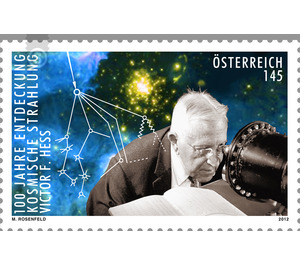100 years - Austria / II. Republic of Austria 2012 - 145 Euro Cent
Theme: Well-known people
| Country | Austria / II. Republic of Austria |
| Issue Date | 2012 |
| Face Value | 145.00 |
| Edition Issued | 270,000 |
| Printing Type | offset |
| Stamp Type | Commemorative |
| Item Type | Stamp |
| Chronological Issue Number | 2329 |
| Chronological Chapter | OOS-OE2 |
| SID | 178587 |
| In 55 Wishlists | |
This special stamp honors a great Austrian in the history of science. Exactly 100 years ago, in 1912, the physicist Victor Franz Hess (1883 - 1964) discovered cosmic radiation, using balloon flights in the earth's atmosphere. For this discovery he received in 1936 the Nobel Prize in Physics. In recognition of this extraordinary scientific achievement, the new special stamp also features a very special feature: the motif is decorated with both a valuable gold foil stamping and a lavishly applied iriodin varnish. Cosmic Radiation is a high-energy particle radiation from outer space that comes from the Sun, the Milky Way and distant galaxies. It consists mainly of protons, but also of electrons and fully ionized atoms. Approximately 1000 particles per square meter and second strike the outer earth's atmosphere. Interaction with the gas molecules creates particle showers with a high number of secondary particles, of which only a small part reaches the earth's surface. The air showers are a few square kilometers in size, but only a few meters vertically. They give hints on the nature and energy of the cosmic primary particles, but the course of the front on the direction of incidence. On one of his balloon ascents, on August 7, 1912, Victor Franz Hess discovered cosmic radiation, which he then called "cosmic radiation". He referred to the unpublished data of the physicist Karl Bergwitz, who registered this already in 1908. A few years later, in 1919, Hess was appointed associate professor at the University of Graz, shortly afterwards to work for two years in the United States, where he researched, among other things, the medical application of radium. Back in Graz, however, he occupied himself mainly for lack of financial resources with the air electricity. From 1931, as a professor at the University of Innsbruck, he headed the Institute of Radiology there, but had to undergo a thumb amputation and a surgery on the larynx due to a suffered radium burn. After the annexation of Austria to the German Reich, Hess was briefly arrested. On May 28, 1938, he was first put on temporary retirement and finally dismissed in September 1938 without notice and without a pension claim. He was also forced to exchange the Nobel Prize money received and invested in Sweden for German Reich treasure notes. In the same year he emigrated to the USA, where he continued his work at Fordham University. In 1944 he received American citizenship. The scientific measuring station at Innsbruck's Hafelekar, where cosmic radiation is observed, is still reminiscent of the great Austrian physicist.


